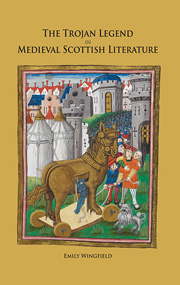Book contents
- Frontmatter
- Dedication
- Contents
- Illustration
- Acknowledgements
- Abbreviations
- Introduction
- 1 Troy in the Older Scots Historical Tradition
- 2 Troy in the Older Scots Romance and Nine Worthies Tradition
- 3 The Scottish Troy Book
- 4 Chaucer's Troilus and Criseyde and Henryson's Testament of cresseid
- 5 Gavin Douglas' Eneados
- Conclusion
- Appendix
- Bibliography
- Index
Introduction
Published online by Cambridge University Press: 05 March 2014
- Frontmatter
- Dedication
- Contents
- Illustration
- Acknowledgements
- Abbreviations
- Introduction
- 1 Troy in the Older Scots Historical Tradition
- 2 Troy in the Older Scots Romance and Nine Worthies Tradition
- 3 The Scottish Troy Book
- 4 Chaucer's Troilus and Criseyde and Henryson's Testament of cresseid
- 5 Gavin Douglas' Eneados
- Conclusion
- Appendix
- Bibliography
- Index
Summary
In Troy there lies the scene
Of Hisarlik in north-west Turkey, the reputed site of Troy, Michael Wood writes, ‘The first thing you notice is that the ruins exist at several levels and that there is not, as it were, one single Troy.’ The historical city on which the legend was based was most probably only ever a relatively small city with one thousand or so inhabitants, but the legend itself has far outstripped these humble origins. It has proved to be one of the most enduring and universal stories of Western civilization, and has inspired writers from Homer and Virgil, Chaucer and Shakespeare, to Dryden, Pope, Byron and Joyce, as well as the makers of epic Hollywood films, such as Helen of Troy (1955), Jason and the Argonauts (1963) and Troy (2004).
As with the city there is, however, no single legend of Troy. A cursory survey of classical and medieval narratives reveals that the legend was both wideranging and capacious, encompassing a diverse temporal and geographic range from Jason's initial search for the Golden Fleece to Aeneas' North African and Mediterranean wanderings. Indeed, we might think of the legend of Troy as a set of Russian dolls – a macro-narrative containing within it micro-narrative histories of several generations of infamous characters such as Jason and Medea, Troilus and Criseyde, and Dido and Aeneas, characters whose stories can exist both in isolation and as parts of a larger whole.
- Type
- Chapter
- Information
- The Trojan Legend in Medieval Scottish Literature , pp. 1 - 21Publisher: Boydell & BrewerPrint publication year: 2014



